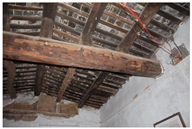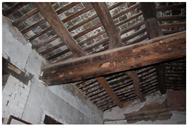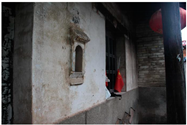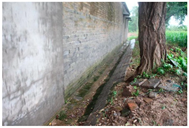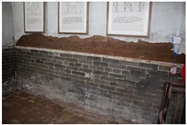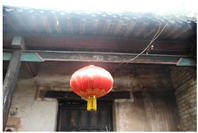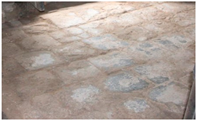Abstract
During the past decades, many traditional vernacular buildings have been forced to be demolished or abandoned due to the accelerating trend of urbanisation in China, which has resulted in regional culture, historical memory, and architectural narratives being gradually lost. The contemporary development of courtyard-style architecture under the influence of Confucianism, an important architectural form that carries Chinese culture, remains unclear. To preserve these vernacular buildings and local culture, this paper traces the historical value of courtyard houses. Through a case study, the effectiveness of local courtyard-style building rehabilitation in Shandong is assessed, and key components, building materials, and construction techniques corresponding to Confucian cultural connotations are examined, leading to a more comprehensive dialectical analysis of building rehabilitation. The results indicated that rehabilitation can be effective in preserving vernacular components and cultural narratives in the context of sustainable development strategies for traditional buildings. Moreover, by identifying and evaluating the sense of place and rehabilitation strategies of the architectural heritage, new perspectives are offered to the world of vernacular architectural practice, and existing knowledge of the architectural courtyard is expanded.
1. Introduction
In recent years, China’s urbanisation has ushered in both opportunities and challenges for the construction industry. Behind the surprisingly high urbanisation rate is a response to the massive renovation of old cities and the consolidation of villages, where the original vernacular architecture is seen as a product of backwardness. Many traditional buildings have been forced to be demolished or discarded for short-term gain. This has resulted in regional cultures, historical memories, and architectural narratives being gradually lost. Architectural styles reflect how people adapt to their local environment and culture while also contributing to the transmission of social norms and order [1]. Therefore, there is a need and urgency to preserve and culturally transmit vernacular architecture, as in 2018, when the Chinese government proposed the Rural Revitalization Strategy, which mentions the preservation of traditional cultural villages and buildings. This strategy promotes the construction of villages and is an effective way to pass on excellent traditional culture. Inheriting and developing vernacular architectural traditions is also a critical task in achieving rural development and revitalising traditional culture [2].
The Chinese architect Mr. Liang Sicheng once warned that architecture is a hallmark of human civilization and an important part of human culture and that the vernacular should never become an adjunct to the city. As early as the 1980s, Chinese vernacular architecture researcher Ronald G. Knapp, in his book China’s Vernacular Architecture: House Form and Culture [3], had a forward-looking record of traditional Chinese building techniques, spatial organisation, settlement patterns, and folk beliefs. However, the architectural paradigm and the cultural connotations behind it have been gradually forgotten in the wake of rapid urban development. It is undeniable that traditional architecture is based on agrarian production methods and has evolved since ancient times through the “trial and error” approach of the ancestors [4]. In addition, according to some researchers, many existing buildings are unable to meet the criteria for the current seismic fortification because they were built based on experience rather than taking earthquake impacts into account at the time of design or because the relevant design specifications have been updated [5]. Indeed, housing forms have evolved in different styles and structures to suit social, cultural, and economic needs. People parallel their religious, environmental, social, and economic functions with the changes in architectural space [6]. Vernacular architecture is produced in response to the culture and traditions held by the inhabitants without ignoring the surrounding society and culture [7]. At the same time, vernacular architecture, created in response to the needs of the natural environment and the lifestyle of its inhabitants, is known in academic circles as “architecture without an architect” [8]. In fact, architecture is linked to culture, which is made up of concepts, symbols, and entities that influence the development of architectural systems from a variety of perspectives, including construction materials, building techniques, and architectural art [9]. As the wheel of history moves from the agricultural age to the industrial one, rural aesthetics and rural values become the most important cultural forces in the process of modernisation, not only marking the innate inadequacies of modern life, but also carrying the permanent nostalgia of human beings [10]. Due to a profound understanding of how these materials, functions, and requirements could be best expressed, the aesthetic of the Chinese house has achieved such elegance of expression despite being based on purely pragmatic considerations [11]. Of these, courtyard architecture, as a vernacular building type in China, has the potential to enhance the comfort of indoor occupants [12]. Courtyard spaces are among the oldest hidden structures in China [13], and they can still be found in both northern and southern China. The symmetrical, multi-layered layout it adopts maps the Confucian philosophy of harmony, cohesion, and unity; it is the link between heaven and earth and where the story of the nation takes place. However, urbanisation has led to the decline of vernacular architecture in China, and the contemporary development of the courtyard as an element representing national identity remains unclear. Courtyard-style architecture has developed through an entire economic, cultural, and political period [14]. It is not only a functional architectural space, but also a place where people tell stories and demonstrate their creativity and sense of place. The heritage spirit of courtyard architecture should therefore be protected [15].
The courtyard-style structure embodies the “form” and “significance” of architectural culture [9]. Confucianism, in turn, was the basis of ancient Chinese culture [16], which originated in Shandong Province, where most of the local houses had courtyards. These courtyards display the ideology of the local people and have a special place in history. Although several scholars have explored the importance of vernacular courtyards and architecture from several specific perspectives, few researchers have focused on vernacular architectural structures and materials in specific regional cultures, as traditional Chinese architecture has been influenced by different regional environments and architectural conditions as well as specific cultural contexts during its long evolution [17]. Therefore, the main issue at present is the lack of scientific and systematic methods to assess the effectiveness of local traditional building materials and construction techniques in Shandong to help revitalise strategies for courtyard-style architecture and to heritage Confucian culture. This study attempts to highlight the spatial activity processes that occur within the courtyard through the architectural element of interiority [18] and to identify strategies for assessing the heritage’s sense of place and rehabilitation from the perspective of the building components that correspond to the cultural narrative. The following chapters of the paper are organised as follows, with Section 2 delving into heritage rehabilitation and the courtyard’s architectural sustainability. The research methodology in this study is described in Section 3. This advances the case descriptions in Section 4. Section 5 introduces the findings and discussions of the paper, and Section 6 concludes and makes recommendations for future research into the conservation and rehabilitation of vernacular architecture.
2. Heritage Rehabilitation and Courtyard Architectural Sustainability
2.1. Chinese Courtyard Architecture and Exoticism
The courtyard house is one of the oldest types of human dwellings, dating back at least 5000 years and occurring in distinctive forms in diverse climates and cultures, including China, India, the Middle East and Mediterranean regions, North Africa, ancient Greece and Rome, Spain, and Latin-Hispanic America [13,19,20,21,22,23]. In numerous communities, institutions, moral systems, worldviews, modes of life, and religion (symbols, rituals, cosmological components, etc.) have all contributed to the development of home forms [24]. Each ethnic group resides in a particular place and has its own culture and traditions; each ethnic group’s living culture strongly reflects the demographic, geographical, and ecological conditions of its home region [25]. There is no denying that protecting cultural heritage is a concern for developing nations, especially where heritage sites are widely dispersed in rural areas and may lack significant structures [26].
- (1)
- China
In terms of structural components, for the construction of the house, wood is the preferable structural material that may be found locally. The housing’s structural system is visible, with wooden columns joined to a wooden beam. The wall is comprised of wood and brick. The outer wall is constructed of brick, while the inside wall is constructed of wood. This wooden frame is attached to the roof in an interlocking pattern, providing protection against natural disasters [27]. For example, in northern Chinese courtyard architecture, the term “four beams and eight pillars” is often used to refer to the “four walls and eight directions”, where the wooden frame is used to carry the loads of the roof and floor, and the seismic force leads, etc. The walls are not load-bearing, but only serve to enclose, separate, and stabilise the pillars. One of the most typical examples of this is the Kao Gong Ji from the Western Zhou Dynasty, which contains accounts of surveying and positioning, the history of architecture, etc., which are discussed in terms of the prescription of form. The tendency of the narrative in this book represents the traditional Chinese view of the question of architectural form as a purely functional or aesthetic issue. Table 1 shows the history of the development of vernacular courtyard architecture in China.

Table 1.
The history of vernacular courtyard architecture in China.
The Chinese courtyard is produced by building a home on each of the four sides of a rectangle or square complex, leaving the centre open for the courtyard’s architecture [27]. Typical courtyard structures have an interior open space that serves as the focal point for all other living spaces [28]. Although there are sometimes variations in the number of courtyards, the core layout principles remain the same [29]. The common form of traditional Chinese houses is shown in Figure 1.
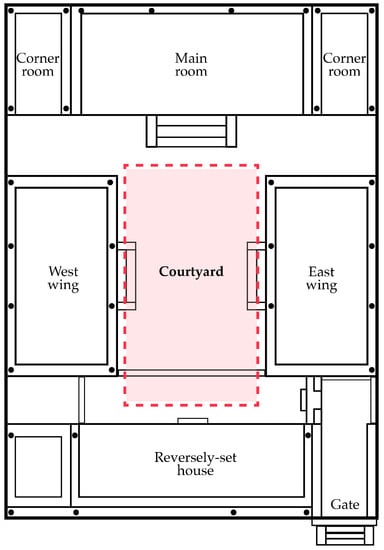
Figure 1.
Layout of traditional courtyard houses in northern China (Drawn by authors).
In fact, the formation of this architectural system, apart from being related to the environment, is also to a large extent related to the cultural context in which it was built. Confucianism, the cornerstone of Chinese history and culture, originated in Shandong province. The ideals of Ren and Li, which were advocated by Confucianism, are reflected in the aesthetic pursuit of an “orderly, natural, and free” design for living spaces. The Doctrine of the Mean is also reflected in the symmetrical structure of the building. This is the approach adopted in most palaces and vernacular dwellings [30]. The courtyard in Chinese architecture is the centre of domestic and social life, and it is often beautifully decorated to reflect the aesthetic interests of the family. At the same time, the courtyard house is the most popular vernacular house type among the various housing patterns in China [31]. It is primarily a rural housing type that can also be well adapted to an urban environment [11].
- (2)
- Malaysia
In Malaysia, there are also vernacular courtyard houses. Such is the case of the courtyard spaces and traditional buildings in George Town, Penang, Malaysia, whose fusion of Chinese culture and historical heritage produces sustainable spaces [32,33]. In addition, traditional architecture in Malaysia is more focused on thermal comfort, where factors such as windows, openings, building orientation, roof design, and various floor levels that enhance comfort affect the ventilation of vernacular buildings. Some studies have found that brick and concrete have a high thermal capacity and are favourable materials for cooling buildings [34]. Furthermore, the courtyard arrangement ensures natural light throughout the house [35].
- (3)
- Palestine
Palestine is a Mediterranean country. Changes in Palestinian architecture and the courtyard house are mostly attributable to the late 19th-century social and economic upheavals. Modern materials, such as iron, concrete, tiles, and cement flooring, which are becoming increasingly prevalent, are used in every hamlet and city in Palestine [23]. For several reasons, the old courtyard buildings provide a better climate than modern buildings. The most striking of these are the insulation, turning, shading, and ventilation [36]. A strong point of vernacular architecture is the harmony between environment and architecture. In this context, Mediterranean vernacular architecture is in harmony with its local environment, which encompasses culture and tradition [37].
- (4)
- Iran
Iran’s courtyard structures are several thousand years old [38]. The development of architectural planning in Iran has emphasised the importance of solidarity, inwardness, and connection with nature in terms of religious beliefs and practises [39]. According to Samadi [40], one of the ancients’ building and spatial organising concepts was the use of natural resources and energies. Meanwhile, in terms of culture, culture is one of the key characteristics of architecture’s core. Privacy is a concept closely associated with culture, and it is undeniably deeply ingrained in Iranian society and culture, which has had a significant impact on the spatial design of Iranian homes [41]. In summary, from a sociocultural, climatic, and physical standpoint, the yard is crucial to the cohesiveness of an Iranian dwelling [38]. Currently, it is difficult for researchers to personally witness and experience diverse actions and interactions in central courtyard residences, particularly in large cities such as Tehran, where new development projects have radically altered the city’s physical appearance [42].
- (5)
- Egypt
In Egypt, the inner courtyard is regarded as one of the most significant characteristics of Arab and Islamic architecture in general. It is the result of human interaction with the surrounding environment and the adaptation of that environment to obtain access to the innermost part of the human being to feel privacy and safety from outsiders [22]. In addition, the orientation and proper configuration of Egyptian courtyard buildings can significantly improve the building’s thermal performance and directly influence the behaviour of users and the function of the space [43]. Egypt has a distinctly desert environment—a hot, dry climate zone with little rainfall and intense sunlight due to its location in a wide tropical desert strip in North Africa. As a result, traditional Egyptian architecture has adapted to these harsh environmental conditions [44]. At the same time, a few sociocultural and religious issues influence the spatial arrangement of Egyptian housing [44]. Since the Islamic house was designed from the interior to the exterior, and not the other way around, emphasis was placed on the internal design of the courtyard through the use of architectural and aesthetic treatments, as well as the various shapes of the cells around the openings, doors, and windows [22]. Significantly, the courtyard brings comfort and security as a special part of the sky owned by the owner, which draws the sky downwards to connect with and enter the room with the person, and this architectural element of the courtyard becomes a source of peace within the house. It is thus clear that the traditional courtyard architecture of Egypt has its own heritage value and that scholars have never ceased to study this effective and sustainable spatial structure within a hot and arid region.
In summary, Table 2 provides an overview of the characteristics of the architectural heritage of China, Malaysia, Palestine, Iran, and Egypt as described above.

Table 2.
Heritage and architectural features.
2.2. Literature Review
Housing remains vital to mankind. In order to protect themselves, humans have built various housing structures, including courtyard dwellings [38]. It is one of the oldest building types still in existence and can be found all over the world (Latin America, China, Europe, and the Middle East) [45]. The spatial form of the building and its shape reflect cultural preferences that are inward-looking and moderate enough to be influenced by climate and production techniques. For centuries, traditional courtyards have played a key role in society and architecture as a means of establishing differentiation [46]. Significantly, the symmetry and perfectly balanced order of the courtyard can be interpreted as the timeless centre of gravity of the dwelling, while the periphery responds to the specific circumstances and pressures of the earth’s environment [47].
From the point of view of vernacular architecture, the growth of vernacular architecture is constant, and it exhibits varied characteristics derived from local cultures, climatic circumstances, and building materials [48,49]. The spatial structure of a house can record the behavioural patterns and unique cultural DNA of its occupants, with other houses sharing the same geographical and cultural context [50]. Vernacular architecture serves a crucial role in transmitting the region’s culture to future generations, hence maintaining historical continuity [48]. Interaction with the surrounding environment involves both separation from and connection to the natural and man-made environments of the interior space. A harmonious relationship with nature can be achieved by exposing the building’s interior spaces to the outside in an ecologically responsible manner [51]. From a typological perspective, it has been argued that the courtyard is a typology that responds to the social and cultural characteristics of the spatial structure of the vernacular [6]. On the other hand, Bracken [11] argued that courtyard architecture is essentially a rural architectural style. Among the hot topics of research on courtyard space in recent years, different authors have focused on different aspects; for example, Porotto [52] suggested that the collective space of the courtyard is used as an “outdoor living room”. As a collection of public and private spaces, the courtyard reinforces the community identity of its inhabitants. Mazinanian et al. [38] identified the courtyard as one of the critical locations to consider when reconstructing a building’s past identity. Furthermore, given the value of integration, the courtyard is a major complementary part of all residential architectural configurations. In fact, the courtyard dominates the design in all cases [53]. In turn, the traditional architectural style reflects the local housing, which transmits culture from generation to generation. Due to the ongoing transformations demanded by social life and the surrounding barriers, vernacular buildings are frequently constructed without the supervision of a professional architect. These dwellings are practically suited for living as well as for other forms of activity [27].
In the study of Chinese courtyard architecture, the common English term “courtyard” is insufficient to distinguish between the many open areas of China. In northern China, the typical quadrangular house is called a “Siheyuan” and has a large courtyard [33]. In this regard, different types of Chinese towns have spatial patterns that represent their unique cultural and social characteristics [54]. As cities face rapid modernisation and urbanisation in the current era, vernacular courtyard dwellings are gradually disappearing. As a response to the global metropolitan environment, urban planners and scholars are working to preserve this important part of Chinese cultural history [55]. Traditional courtyard spaces have been used throughout the development of traditional Chinese architecture, carrying rich cultural connotations and reflecting its philosophical and aesthetic concepts [56]. The inner and cohesive nature of Chinese vernacular courtyard architecture reflects the spiritual core and introverted qualities of the Chinese [57]. This architectural form can also be seen as a successful sustainable design strategy, as it serves the dual functions of privacy and security [55].
In summary, the preservation of traditional courtyard architecture is vital to the cultural heritage of housing in China and around the world. There are also many forums and projects on sustainability and architectural revival in many countries and regions. However, as mentioned earlier, the decline of vernacular architecture due to urbanisation in China and the contemporary development of traditional courtyard architecture are still unclear, and little research attention has been paid to either the assessment methods, construction techniques, or the cultural connotations mapped by the building components. In response, this study attempts to propose a series of methodologies and a matrix framework to systematically assess the scope of rehabilitation of vernacular courtyard buildings and the principles of living use of the corresponding heritage, and to analyse and discuss the current shortcomings and future directions of this research in a typical case study in Liaocheng, Shandong Province.
3. Research Methodology
This study adopts a qualitative research approach, including literature collection, physical investigation, and analysis of components, leading to the compilation of a relatively detailed description of the rehabilitation design. Based on research and literature collection, the researchers sorted out the characteristics of traditional buildings influenced by Confucian culture and then carried out a long-term follow-up investigation of a typical case in western Shandong. First-hand and second-hand data were combined in order to establish the principles of architectural rehabilitation and cultural transmission. Through the analysis of the building’s rehabilitation techniques and cultural connotations, strategies and methods for the rehabilitation of such vernacular architecture are explored. To investigate the building systematically and scientifically, as well as the courtyard space, this study also refers to national technical standards and extracts from the relevant literature in relation to the rehabilitation of the building. As Confucian heritage was assessed as a more abstract component, one-on-one interviews with experts were conducted, as well as semi-structured interviews with villagers, to identify and describe regional cultures, stories, and events more effectively. This was part of the methodology of this study, which attempted to record and describe the lives demonstrated by the participants or subjects, and its use allowed for the emergence of voices that could not be heard during the decay of the building, thus better integrating organically with the building components and materials. The main contributions of this study are as follows:
- (1)
- Using physical space as a vehicle, the philosophical meanings of Confucian culture are compared and dissected with architectural elements to better show the importance of cultural heritage in traditional architecture.
- (2)
- The technical rehabilitation and cultural transmission of courtyard-style buildings are the focus of this study. This includes a description of the living use of heritage buildings, the scope and content of rehabilitation, and maintenance techniques. As discussed earlier, the main research objective of the current study is to apply a scientific and systematic approach to assess the effectiveness of local traditional building materials and construction techniques in Shandong to help revitalise strategies for courtyard-style architecture and the transmission of Confucian culture.
The research framework is shown in Figure 2 below.
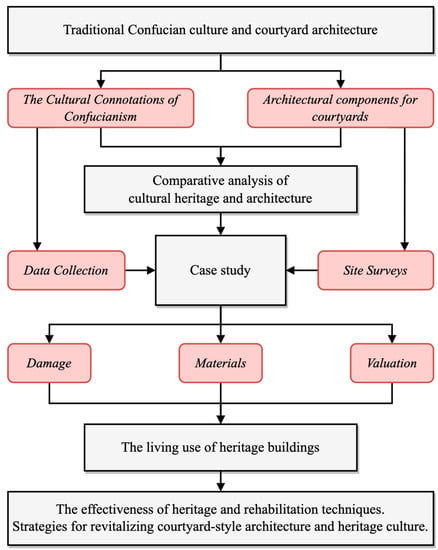
Figure 2.
Research framework.
4. Case Description
Based on a literature review, the basic model and status of traditional courtyard houses are understood. To some extent, it can be interpreted as ancient people’s homes. This study focuses on Shandong Province, located in the northern coastal region of China, as shown in Figure 3. In selecting the courtyards considered for this study, reference was made to data from the People’s Government of Shandong Province, which leads the country in the number of provincial-level cultural heritage protection units with a total of 1968. The Sixth Batch of Provincial Cultural Heritage Protection Units was published in January 2022 and contains 85 ancient buildings. This study addresses this batch and refers to the ancient architecture of Shandong. Twenty-seven cases were located (including Confucian courtyards studied throughout the province). Since the 1990s, as China’s urban and rural real estate markets have heated up, many traditional dwellings have been demolished, making it difficult to find intact courtyard complexes, a phenomenon exacerbated by the historical invasion of coastal areas and Western architectural styles.
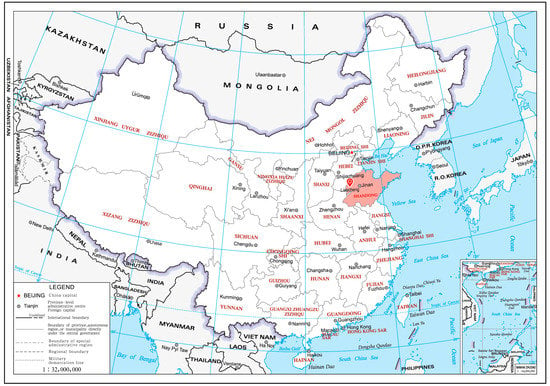
Figure 3.
Location of Liaocheng City in Shandong Province, China (figure from the Standard Map of the People’s Republic of China; Approval Number: GS (2019) No. 1679).
In the cities of central Shandong (e.g., Jinan, Tai’an, Qufu, and Zibo), dwellings with courtyards are well preserved and relatively intact, as they are located in mountainous areas where access is difficult and modern life is less intrusive; in the western cities (e.g., Liaocheng, Dezhou, and Heze), where land resources are abundant and located in the plains, the buildings and attached courtyards are larger in size. To ensure the credibility and neutrality of this study, the fieldwork was carefully selected through expert advice and a process of data collection. Table 3 shows the evaluation criteria used to choose the cases for this study. These criteria were based on UNESCO’s rules for choosing World Heritage sites and relevant criteria for studying Confucian architecture and courtyards.

Table 3.
Confucian architecture (Courtyard) selection criteria.
The researchers visited the target cities and found that much traditional architecture and vernacular courtyards had been demolished because of government activities (including land acquisition and new rural renovation), while many buildings had also been incorporated into the cities and conserved as heritage units. During the fieldwork, the main body of a traditional dwelling in Hexiarong Village, Liaocheng City, was relatively well preserved and had not yet been systematically restored. Therefore, for this study, a scientific and systematic approach can be attempted to assess the effectiveness of traditional building materials and construction techniques. The geographical location of the building is shown in Figure 4.

Figure 4.
Location of the case building in Liaocheng City, Shandong Province (figure supervised by Shandong Provincial Department of Natural Resources Compiled by Shandong Provincial Institute of Map; Approval Number: LU SG (2022) No. 034).
At the same time, the natural conditions in which the building is situated are described in the following three ways:
- (1)
- Topography
The building is in the Yellow Plain of north-western Lu, part of the North China Plain, with an open and flat topography, slightly high in the south-west and low in the north-east. It has been affected by the Yellow River outfall and natural erosion many times in its history, forming a slightly undulating plain landscape. The slope of the land is 1/6500–1/7500, with an average altitude of about 38 m. The main micro-landscapes are riverbank uplands, gently flat slopes, and depressions in the backwaters. The basic seismic intensity of the site is 7 degrees.
- (2)
- Climate conditions
Liaocheng City has a semi-arid monsoon regional continental climate with four distinct seasons, abundant light, and a long frost-free period. It has significant seasonal changes and monsoon climate characteristics, with dry and windy springs, simultaneous rain and heat, a hot and rainy summer, a cool and dry autumn, and cold temperatures and little snow in winter. The overall climatic conditions are good, with an annual number of light hours between 2463 and 2741, an average temperature of 13.3 degrees, an annual average precipitation of 610 mm, and a frost-free period of more than 201 days.
- (3)
- Hydrogeology
The region is relatively rich in water resources, with rivers and ditches running through the territory and good water quality, consisting of surface water and groundwater. Groundwater quality is excellent, and the water layer is shallow, with the water table at around 20 m. Surface water comes from rain and runoff from rivers, with the Majia River being the most important transit river.
Regarding the building itself, it was built in 1870, during the Qing Dynasty, when the vernacular courtyard-style building system was more established. It is of brick and timber construction. The main building is divided into two rows, with three main rooms and two auxiliary rooms in the back row and three rooms in the front row. On both sides are three rooms each for the east and west wings, for a total of 14 houses. The main door faces east, and the second door faces south. The woodwork of the former residence is finely carved, and the brickwork is ingenious, making it a representative of the art of local courtyards in Liaocheng. The original area covers 853.9 square meters, and the original building area is 294.6 square meters. Due to the age of the building, only 11 rooms with a floor area of 193.4 square meters remain (including the restored part). However, the original style can still be seen. In the courtyard, there is a century-old jujube tree (planted in 1870, after the house was built), a Chinese acacia tree (more than 70 years old), a pair of mortar horns, a Guandi temple stele dating from 1622 (the second year of Tianqi) with its body and base well preserved, and a Xuandi temple stele, which is even older. As shown in Figure 5, photographs were taken, and architectural restoration drawings were made based on on-site research and oral interviews with villagers.

Figure 5.
(a) Courtyard and building before rehabilitation. (b) Panoramic view of the courtyard. (c) Oral description of the original building. Photo and hand-drawn by W. Rong.
The above is a brief description of the case. Based on the exterior, components, and technical aspects of the building, the current condition and damage of this case were investigated, covering the roof tiles, wooden structure, walls, interior floor, and courtyard ground.
- (1)
- Regarding the roof tiles, the roof has lost its original slope due to the absence of individual timber frames, such as the interior triple-frame beams, and the roof does not drain smoothly, resulting in slight rain penetration. The roof was originally made of grey dry-hewn tiles, but the curvature of the roof was reduced due to the removal of the beams, and the roof was made of flat tiles, which were laid in a simple and rough manner. Furthermore, due to later construction on the east and west sides of the main house, the original main house building was expanded into seven rooms, the seven rooms share a roof, the original main house roof ridge pieces are all missing, and now only in the overall building roof on the east and west sides can a simple row of green bricks be used instead of roof ridge pieces, and they are filled with cement to strengthen them. This is prone to safety accidents and poses a hazard to the building itself.
- (2)
- Next is the wooden frame. Due to the inevitable weakening and damage to the material and structural properties of timber construction heritage because of long-term weathering and man-made and natural disaster damage, there are common diseases of the wood structure, such as dry shrinkage and cracking, defects in the wood itself (strength of the wood and angle of the mitre, etc.), and decay (mycelium and mould). Therefore, the investigation revealed the following issues with the wooden part of the building case: The five beams on both the east and west sides of the building are cracked from south to north, with a crack width of 4 cm and a depth of 5 cm; the rest of the beams are well preserved; the original three beams were removed, and the gourd pillar and the original gold pillar sit directly on top of the five beams, supporting the five purlins in the interior; the head-holding beam is directly erected on the inner pillar of the front gable wall, linking the gable pillar; and the head-holding beam is well maintained. In addition, the front gable wall is made of gold columns, which are slightly split and decayed. The gable pillars in the east and west walls of the rear gable wall are badly decayed, causing the wall to appear distorted, the overall structure to be deformed, and the rear gable to settle. The west side of the gourd column is cracked, with its length running through the column and the width of the crack being less than 30 mm; one section of the column is sawed in half, and the rest of the column is cracked in various ways.
- (3)
- Regarding the walls, the front gable wall upper body overall after white plastering has 60% heavy contamination. The lower alkali overall was covered with water-brushed stone paint; now the water-brushed stone surface is 20% off and there is 10% pollution. The east side of the Edward wall has slight weathering on the pad flower brick and lotus pier brick carving, the west wall is moved to the west to complete the whole building, and the door on the east side is used to access the shrine (heaven and earth kiln). The wall brick has crisp alkali depth of 5–15 mm with 30 pcs of green brick. The back eave wall has serious decay of the columns within the wall, resulting in rain penetration around the columns and moss contamination of the wall. The wall under the alkali green bricks is heavily peeling off the grey joints, and the wall green bricks are slightly loose; the back eave wall has moss contamination on the surface of the green bricks due to the dampness of the wall under the alkali.
- (4)
- For the interior floors and courtyard grounds, the floor of the bright interior room is the original square brick, which measures one foot, and the original square brick floor is on the verge of being crushed. The floor of the west secondary room was later changed to a red brick floor. As the floor was later changed to pavement tiles, this resulted in a height difference between the interior floor of the east secondary room and the rest of the floor. The surface of the square brick floor in the corridor was later covered with a layer of cement plaster. The individual brick pedestals are covered with cement plaster, and 20% of the pedestals have severe alkali chalking.
In conclusion, Table 4 provides a summary of this building. A systematic review of traditional building materials and construction techniques was undertaken to facilitate the specific rehabilitation work that will follow. Only if the building proper is preserved can further strategies for revitalising courtyard-style architecture and local heritage be proposed.

Table 4.
Case status and investigation collation.
5. Findings and Discussions
Based on the information from the above-mentioned investigation of the vernacular courtyard buildings in Liaocheng, it is possible to assess the effectiveness of the heritage of traditional buildings through two main aspects, which include cultural heritage and architectural components. Both complement each other, with building components serving as cultural heritage entities and the preservation of traditional architecture serving as a means of transmitting history and urban culture. A culture, nostalgia, or the local narrative is an in-built cultural heritage, and its conservation and the development of rehabilitation techniques based on it can help people remember this nostalgia more vividly.
Overall, the relationship between these two aspects is illustrated in Figure 6. In the following sections, the characteristics and values of courtyard architecture are highlighted again, and the specific practical approaches and conclusions of architectural heritage rehabilitation are argued through the technical means employed.
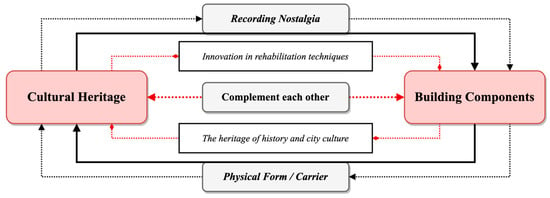
Figure 6.
Two aspects of assessing the validity of traditional architectural heritage.
5.1. Appearance and Characteristic
Numerous studies confirm that in northern China, buildings with courtyards were preferred by the people because of their flexibility and expandability, and the layout of the house was adapted according to the wealth of the head of the household. Courtyard houses were coded to represent and reproduce the well-defined social relations that underpinned Confucianism’s moral order. The influence of Confucianism on ancient Chinese architectural culture, both in terms of appearance and character, is fundamental and specific to Confucian thought and doctrine [58]. Confucian culture, which creates distinctive Chinese architectural landscape and artistic character, transmits culture [16].
Guo and Dou [57] argued in this regard that architecture has always served society with its functions in both material and spiritual terms, rather than simply as a shelter. The courtyard space has thus survived the development of Chinese civilisation, serving as a tangible cultural carrier and revealing a rich ideological connotation. In fact, this fits the Confucian concept of Li, which can be roughly translated as “social norms” or “etiquette”. It reflects the Li that Chinese people are taught from a young age. Liang Sicheng’s A History of Chinese Architecture and Liu Dunzhen’s An Introduction to Chinese Houses provide a comprehensive account of the form of courtyard buildings, as well as a summary of traditional Chinese courtyard arrangements that were influenced by traditional religious rituals [19]. Thus, the architectural form of the courtyard space implies a respect for rules and order, and the pursuit of a “progressive” courtyard space is in fact a requirement to follow the rituals [57].
In this living space, the Chinese focus on neighbourhood interaction and family communication, as well as exchange with and integration with nature and the landscape. This pursuit of a harmonious blend of people, architecture, and nature has been a traditional way of life for the Chinese people for thousands of years, full of humanity [59]. Further, as the focus of family and social life, the courtyard was frequently exquisitely furnished, reflecting the artistic preferences of the home [11]. Moreover, as the core of the entire structure, the courtyard space is not only an essential location for daily living and family gatherings but also embodies the family’s personality [9]. Furthermore, communal courtyards scattered throughout traditional settlements serve as daily meeting places for villagers and can accommodate activities such as neighbour communication. The quality of the courtyard space directly or indirectly affects the quality of life of the residents [60]. From this, it is easy to see that Confucian ethics are implicit in traditional Chinese architecture, such as the traditional decorative aesthetic codes embodied through technique, structure, and layout. It is also a metaphor for events that occur through visual shapes, spatial axes, scaled façades, decorative components, and cultural semantics that go far beyond the functionality of the vernacular building as a “shelter”. A traditional Chinese courtyard house would typically accommodate three or four generations of a family. The physical design of certain expansive courtyard villas expresses social status in a straightforward way [24]. Interestingly, researcher Bracken [11] proposed the concept of “graduated privacy” for the courtyard, a series of spatial activities that take place in the home where temporary visitors are only invited to the entrance porch, but friends and family have access to the first courtyard and its adjoining hall. The deeper recesses of the house are reserved for private family events. This means that the house is seen as a place where ceremonies are held and where a family can call itself home. This series of spaces in Chinese architecture, from birth to growing up, marriage, childbirth, and so on, until death, is meant to tell people not only where they come from but also clearly where they are going in the future, effectively giving them cultural meaning.
As shown in Figure 7, the coin-shaped openwork stone wall panels symbolise the expectation of a good life of prosperity and family harmony, the simplest expression of culture for the head of the household. At the same time, as shown in Figure 8, the wall shrine demonstrates the local understanding of the concept of heaven and earth, identification with the local culture, and a sense of family honour, a sense of place, and sacred space shaped by religious and cultural symbols, or “soft” attributes, which are as important as the “hard” structural features of the building [61].
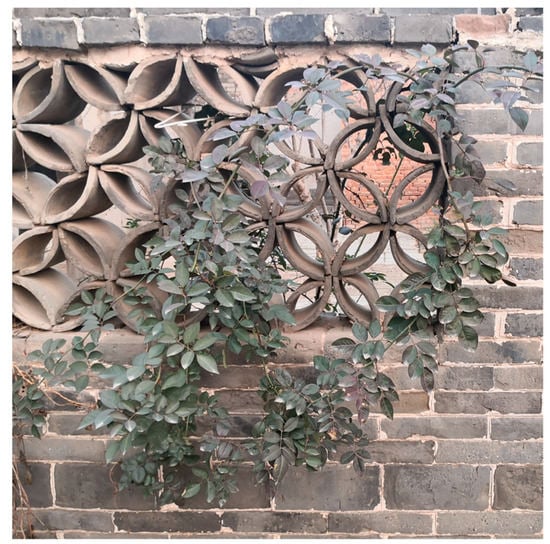
Figure 7.
Tile wall decorations. Photo by W. Rong.
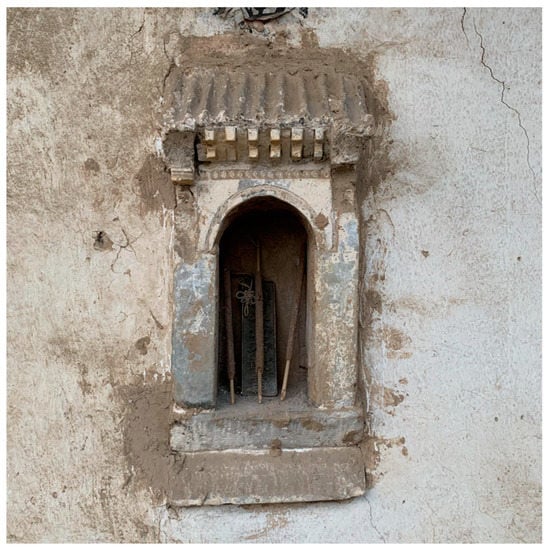
Figure 8.
The shrine of expecting good wind and rain. Photo by W. Rong.
In summary, the philosophical connotations of Confucianism and the narratives it conveys can be summarised in its corresponding housing planning requirements, such as the ease of use of the living space, the emotional transformation of the space in which people live, and the sustainability of these local narratives. For implementation into specific building components, this is reflected in spaces such as patios, courtyards, compartments, ear rooms, and main rooms, whilst stone carvings and stone paving map the cultural heritage in the building, as shown in Figure 9.
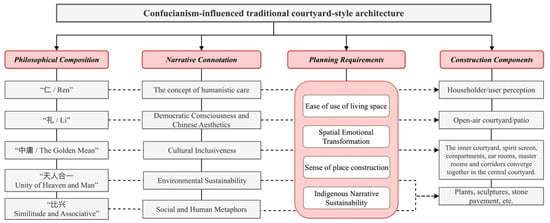
Figure 9.
Confucianism and relation of traditional courtyard-style architecture components.
However, having discussed the value of architectural heritage, there is still a need for further exploration through technical means in terms of specific rehabilitation strategies. All rehabilitation measures are designed to achieve a conservation-focused purpose that, to the greatest extent practicable, prevents the removal or replacement of material or structural elements [62]. In response, the following sections present the effective use of local materials, construction techniques, and resources. The task of rehabilitating and passing on traditional courtyard architecture is maximised, thus contributing to the field.
5.2. Rehabilitation and Conservation Technical Notes
Heritage buildings are part of human creation, creating icons for a country, providing local identity, reflecting cultural values and context, and representing sources of memory and historical events [63]. Therefore, regarding historical and cultural buildings, these radiant national traditions and local narratives should not disregard or ignore the traditional cultural roots of architectural forms. As a result, different methods of rehabilitation should be applied to buildings with varying degrees of damage to comply with their historical character in time and the continuity of their use functions in space in order to achieve a balance between conservation and rehabilitation.
- (1)
- The principle of authenticity
For the rehabilitation of the appearance of traditional buildings under the influence of Confucianism, the historical information required to continue the form and variation of the building structure and material texture should be preserved as a historical memory. In addition, historical authenticity is maintained in the rehabilitation process with the principle of minimal intervention, ensuring that the original form and scale of buildings and structures are maintained as far as possible, and that traditional materials and techniques are used in the rehabilitation process and that new materials and techniques are used when traditional techniques cannot solve the problem. Where modern techniques must be applied, those components that do not correspond to the original building should be clearly distinguished from the original structure.
- (2)
- The principle of in situness
The need for minimal intervention and the preservation of historic structures is paramount [62]. The design of the conservation plan is based on scientific analysis and investigation, field tests, and an evaluation of the effects. The choice of conservation methods and materials guarantees the principles of their safety and reprocessability. The traditional style was determined on the basis of thorough research, respecting the relevant historical data and the use of traditional techniques and materials, excellence, and the preservation of the style according to local conditions, so that the rehabilitation of the traditional architectural features is best protected. The whole process also needs to be well documented in the rehabilitation archives.
5.2.1. Structure and Components
The following findings can be obtained from the actual rehabilitation of the case: Among the overall construction steps for the timber frame and wooden base are documentation of the current condition, overhaul, repair or replacement fabrication of large timber elements, dismantling of the deteriorated wooden base, lifting of large timber elements, and fabrication and installation of rafters. Following on from this, the deterioration of the sorghum pole weave-laid timber frame was characterised by rotting, splitting, bending, sagging, crooked flashing, and tenon pulling of beams, purlins, and square. In addition, the wooden base mainly appears rotten. For the various diseases mentioned above, different actions are taken depending on the situation. Figure 10 shows the elevation of the courtyard and building.
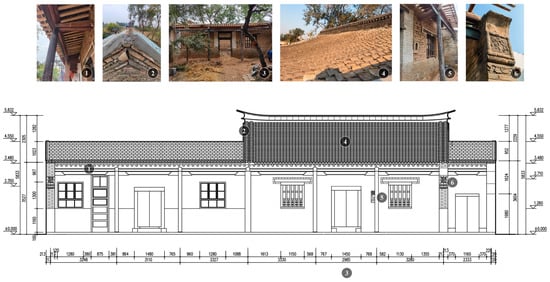
Figure 10.
Building and courtyard façade and main components.
- (1)
- Column rehabilitation
For the preservation of columns with rotten roots not exceeding 1/3 of the column diameter, first the rotten part of the column is picked with a chisel or flat spade into a geometric shape that can be easily patched, such as a triangle, square, semi-circle, circle, etc. The area to be shaved is such that the maximum part of the column that is not rotten is retained. For split columns, the following method is used depending on the degree of splitting: for small, minor cracks (within 0.5 cm, including small natural cracks), epoxy resin putty is used to block the cracks tightly, and for cracks wider than 0.5 cm, wooden strips can be glued and patched tightly, using the same procedure as for digging. If the cracks are irregular, they can be made into regular grooves with a chisel and shovel. The columns buried in the wall are relatively heavy due to the long period of time they are enclosed in a humid environment and are subject to replacement or splicing during the construction process. Wooden elements that have not been replaced and those that have been replaced are preserved by two coats of tung oil.
- (2)
- Beam rehabilitation
In case of splitting or tenon pulling, the reinforcement and protection measures are to repair the cracks in the side of the beam up to 1/2 of the length and 1/4 of the width of the beam, with epoxy resin putty to block the cracks up to 0.5 cm wide. If the width of the crack exceeds 0.5 cm, it should be filled with old wooden strips and reinforced with epoxy resin (which has a strong penetrating power and is stronger after curing, thus increasing the strength of the beam). This method allows for maximum preservation of the original elements of the building and the original state of the wooden frame structure, thus maximising the preservation of the original cultural narrative and historical imprint carried on the original elements.
- (3)
- Timber substrate rehabilitation
For decaying timber substrates caused by dampness, rainwater, and excessive roof loads, the repair process involves total replacement. The less-corroded rafters will continue to be used if they do not affect the weight of the roof after the decay has been removed. For the replacement of the rafters, even the eaves and tile mouth are according to the original size and method of laying nails. All wooden base elements are painted twice with bitumen oil before concealment to prevent cracks, corrosion, and insects.
- (4)
- Methods of preventing corrosion
In general, the biological corrosion of wood is crucial in the rehabilitation of ancient buildings. Thus, a combination of empirical methods of protection in vernacular architecture, combined with current conservation techniques, can provide the following methods for future wood preservation: first is to inhibit decay caused by parasitic wood-rotting fungi, which can be reduced if the moisture content of the wood is below 20%. In addition, wooden elements such as beams and columns should be properly ventilated, and if this is not possible with structural measures, they can be painted or impregnated with a wood preservative, which also provides a fire protection effect. Furthermore, the insects that commonly damage houses in China are termites, for which ecological preventions, namely natural ventilation and light penetration, amongst others, are used in future rehabilitation or design, followed by the use of anti-ant medication to address the situation.
- (5)
- Timber material requirements
It has been argued that the assessment of the value of architectural heritage is the key to heritage conservation, on the basis of which the level of conservation, content, strength, and possibility of reuse after rehabilitating heritage buildings are determined [64]. Therefore, for traditional Chinese wooden building structures, timber defect values and moisture content try their best to meet the selection criteria of the Technical Code for the Maintenance and Strengthening of Wooden Structures in Ancient Buildings and other relevant codes. In this regard, Table 5 and Table A1 summarise the rehabilitation measures for the above-mentioned structures and components.

Table 5.
Rehabilitation measures (Detailed protection is attached as Appendix A).
The overall construction of the timber frame and substrate has been mentioned above. At the same time, the rehabilitation practices of the walls and wall surfaces as the main structure of the building are equally important. When the wall is partially demolished, the new brick and stone components should be of the same specification and quality as the original wall’s brick and stone, and the wall should be built in accordance with the original traditional practice. Use dismantled bricks and stones as much as possible to preserve more of the building’s historical information. The processing of crisp alkali and damaged bricks is mainly used in areas where the walls are well preserved and where the bricks are locally fractured and crisp. For wall bricks with a small depth of alkali, clean up the surface of the alkali parts and preserve them under the status quo.
Furthermore, on green brick walls, it is common practice to remove the wall for later repair with cement mortar or modern paint, followed by re-hooking with white plaster mortar. The white plaster walls are cleaned by removing the bulging and contaminated plaster, cleaning the surface of the stone or earthenware base walls, masonry adobe on the walls, 10–40 mm of wheat straw mud priming, and 3 mm of spar plaster covering. Overall, the original form and cultural connotations of the courtyard and the various parts of the building structure have been preserved. This architectural example demonstrates, in terms of its overall functional layout, the construction of the building under the influence of Confucian culture, and its restoration can largely serve as an important model for the conservation of Confucian dwellings in the Shandong area. In the following section, vernacular materials and traditional construction techniques are described in more detail. Figure 11 represents the construction of part of the wooden structure and the side walls.

Figure 11.
Building side rehabilitation practices.
5.2.2. Materials and Technologies
This section shows the materials and techniques involved in the rehabilitation process through the following sections: roofing practices and the repair of painted finishes. In Figure 12, some of the building materials and building methods used in this study are shown.
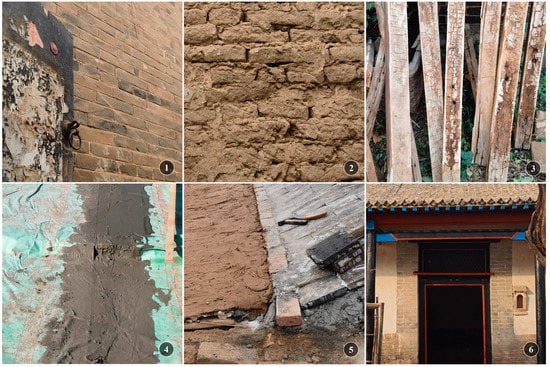
Figure 12.
Materials for courtyard-style Confucian architecture: 1—green bricks, 2—wall blanks, 3—Larchwood, 4—JS waterproof layer, 5—thatched back (ShanBei), 6—painted finishes. Photo by W. Rong.
The different perceptions of traditional buildings stem from the belief in their environmental sustainability [63]. In this regard, for the roofing section, local people were consulted prior to construction to understand the work practices, and local techniques and raw material ratios were followed. As shown in Figure 13, the thatched-back (ShanBei) technique is the most common vernacular construction technique in northern China, particularly in Shandong Province. To prevent the roof from leaking, thatching and repairing rafters are carried out immediately after the removal of the roof tiles, and rainproof thatching sheets are prepared to cover the roof at any time. Thatching should be carried out after the repair of the timber frame and rafters is completed, and the exact thickness of the back should be increased or decreased locally according to the lift of the timber frame, with the back of the eaves and the ridge being slightly thinner. The thickness of the ashlar backing determines the curve of the roof. Depending on the roof rafters and the tiles, the thatched backs are repaired according to the original practice, with reference to local traditional techniques for layering. For instance, from the bottom up, 25 mm thick Wang brick (reed foil), 20 mm thick sheathing plaster, and 50 mm thick, slippery straw mud are applied in two layers, finding the curve of the layer as they go. Wait for the tiles to dry, and then hang them with the plaster.
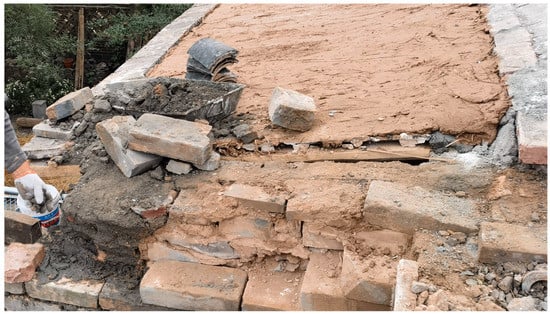
Figure 13.
Thatch back (ShanBei) construction process. Photo by W. Rong.
After that, the JS waterproofing coating construction method was used, and its specific steps are as follows:
- (1)
- The base surface must be firm, clean, flat, and moist. If there are pores and cracks, cement mortar should be used first to achieve repair and smoothing.
- (2)
- JS waterproof coating in the cement, according to a 1:0.8 weight ratio mix, is fully mixed to no particles into a uniform slurry. Adhere to intermittent mixing in the application process to prevent layered deposits. In the construction, JS waterproof coating is directly painted on the substrate with a brush or roller brush, with the strength of the application uniform. If it is used for moisture, only one layer needs to be painted, but for waterproofing, two to three layers must be painted.
- (3)
- At the end of the waterproofing coating construction, the coating must be protected before it dries thoroughly, including from pedestrians, rain erosion, exposure to the sun, sharp object damage, etc. The JS cement-based waterproofing emulsion coating does not require any other protective layer after it has dried completely.
- (4)
- It is advisable to cover the coating with a wet cloth or spray the coating with water 24 h after the water emulsion coating has been applied, usually for 2–3 days. When the air is humid and poorly ventilated, the drying time can be longer.
The last point is about painted finishes. For better-preserved components that do not require repair or replacement, a simple finish is sufficient. For the wooden components that need to be repainted, first clear the surface of the damaged paint, then use a fine grey and white putty to wipe the surface twice, dry it and sweep it clean, and finally brush it with three coats of black or red paint. The colour decoration of the wooden elements has both the role of beautifying the appearance of the building and the role of protecting the internal wooden elements, but due to natural weather erosion and human factors, resulting in ground battles, obsolescence, chalking, peeling, and other diseases of the wooden elements, they seriously affect the ornamental architecture and the preservation of the integrity of the components. As a result, the solution is to use physical methods (distilled water, brushes, and shovels) to remove the old and discoloured surface oiling of the wooden elements, and then to perform the groundwork and paint finishing on the components as originally carried out.
Through the above summary of the building’s structure, rehabilitation methods, and construction techniques, and considering its historical use, the building was identified, its current condition summarised, and the rehabilitation principles of in situ and authenticity were proposed for its current condition. While this is typically the best option for the preservation of this legacy, the unique architectural characteristics and historical significance of these buildings should not be overlooked, and efforts should be made to preserve these characteristics [65]. Therefore, this study uses traditional techniques and materials to carry out a holistic rehabilitation, which will help to perpetuate the architectural heritage of this traditional Confucian context while respecting and preserving its original history, story, emotion, and cultural values.
6. Conclusions
In the context of China’s urbanisation, the survival of vernacular architecture is still being squeezed, and the pace of building rehabilitation is being outpaced by urban planning. As a representative form of traditional Chinese living space, the courtyard house has been influenced by Confucianism, even though some designers have applied it to modern housing, and it is still unclear what the heritage value of these traditional courtyard buildings is and what the cultural heritage is. On the other hand, as the call for sustainable development grows, the regular and hierarchical planning layout of courtyard architecture responds to traditional Chinese architecture and Confucian culture. Using a vernacular courtyard-style building within the city of Liaocheng in Shandong Province as an example of research and practice, this study explores the transition from Confucian narratives to specific rehabilitation, providing a more systematic approach to the conservation and transmission of this building. Meanwhile, the study is a pioneering attempt to provide insights into vernacular architecture and courtyards. This work contributes to the understanding of this type of architecture and suggests ideas for the conservation and rehabilitation of vernacular architecture. The major conclusions that can be drawn are:
- The original cultural activities and heritage preserved in the Confucian courtyard house are a testimony to history. This traditional living environment, which tells a story about culture, can be an important seal of approval for the sustainability of traditional architecture.
- The study of traditional architecture should explore the historical elements of the building, namely the spirit of place, the sense of identity, the sense of direction, and the appeal of the environment to people. Furthermore, following the historical characteristics and use of the building, different rehabilitation methods should be adopted for buildings with varying degrees of damage, considering the appropriate local conditions and construction methods, thus achieving a balance between conservation and rehabilitation.
- Key components that reflect the architectural style, such as roofs, beams, purlins, eaves, doors and windows, and floor coverings, need to be rehabilitated and maintained in their original form. Modern materials and techniques should be carried out with respect for traditional construction techniques.
- A completely modern rehabilitation design is an inappropriate approach, and the existing values and characteristics of the building should be maintained to preserve the authenticity of the different historical information and respect the cultural identity of the building.
- The strategies proposed in this study are not set in stone. Instead, they can be changed and updated based on what is new in building rehabilitation for better quality assessment and building sustainability.
Author Contributions
Conceptualization, W.R. and A.B.; methodology, W.R. and A.B.; software, W.R.; investigation, W.R.; writing—original draft preparation, W.R.; writing—review and editing, A.B.; visualization, W.R.; supervision, A.B.; project administration, W.R. All authors have read and agreed to the published version of the manuscript.
Funding
This research received no external funding.
Data Availability Statement
Not applicable.
Conflicts of Interest
The authors declare no conflict of interest.
Appendix A

Table A1.
Wooden component rehabilitation practices.
Table A1.
Wooden component rehabilitation practices.
| Item Name | Damage Condition | Rehabilitation Practices |
|---|---|---|
| Beam | When the splitting crack width is ≤5 mm. | Use putty to outline the seams when the base is to be treated with a paint finish. |
| Splitting crack width is >5 mm, not more than 15 mm, length not more than 1/2 L, and when the depth does not exceed 1/4 B. | Use dry wood (wood of the same material as the post) and glue it with epoxy E-44. | |
| When the rotten depth is greater than 20 mm. | Use permethrin compound at 0.3–0.5 kg/m3 or 300 g/m2 with 7504 Organochlorine agent to perform anti-insect and anti-corrosion methods. | |
| Purlin | The rotten depth is ≤5 mm. | Use dry wood (of the same material as the post) and glue with epoxy E-44 glue. |
| Rafter | When the straight rafters are rotten, when the rotten depth is within 20 mm, and the length is less than one-third. | Use permethrin compound at 0.3–0.5 kg/m3 or 300 g/m2 with 7504 Organochlorine agent to perform anti-insect and anti-corrosion methods. |
| When the depth of rotten rafters is less than 20 mm. | When repairing the roof, the length of the old rafters is removed and adjusted for replacement to make up for the length. | |
| When the depth of the rotten rafters exceeds 20 mm. | Wood for redoing the flying rafters should be given priority to the use of old wood of suitable size and quality. | |
| Wooden decoration | Partial missing. | Preference should be given to the use of old wood that meets quality requirements. |
| Cracks exist in wood frames or wood components. | When redoing the paint finish to treat the substrate, use putty to fill and level. |
References
- Pang, K. Chinese Architecture: Features, Culture, Types, Décor. Available online: https://www.chinahighlights.com/travelguide/architecture/ (accessed on 28 June 2022).
- Pan, M.; Shen, Y.; Jiang, Q.; Zhou, Q.; Li, Y. Reshaping Publicness: Research on Correlation between Public Participation and Spatial Form in Urban Space Based on Space Syntax—A Case Study on Nanjing Xinjiekou. Buildings 2022, 12, 1492. [Google Scholar] [CrossRef]
- Knapp, R.G. China’s Vernacular Architecture: House Form and Culture; University of Hawaii Press: Honolulu, HI, USA, 1989; ISBN 978-0-8248-1204-1. [Google Scholar]
- Dong, X.; Liu, J. Research on Regional Adaptability and Inheritance of Traditional Residential Courtyards in Qinling Mountains. Build. Sci. 2022, 38, 79–87, 96. [Google Scholar] [CrossRef]
- Cao, X.-Y.; Shen, D.; Feng, D.-C.; Wang, C.-L.; Qu, Z.; Wu, G. Seismic Retrofitting of Existing Frame Buildings through Externally Attached Sub-Structures: State of the Art Review and Future Perspectives. J. Build. Eng. 2022, 57, 104904. [Google Scholar] [CrossRef]
- Hatipoğlu, H.K.; Mohammad, S. Courtyard in Contemporary Multi-Unit Housing: Residential Quality with Sustainability and Sense of Community. Idealkent J. Urban Stud. 2021, 12, 802–826. [Google Scholar] [CrossRef]
- Darmayanti, T.E.; Bahauddin, A. Understanding Vernacularity through Spatial Experience in the Peranakan House Kidang Mas, Chinatown, Lasem, Indonesia. ISVS E-J. 2020, 7, 14. [Google Scholar]
- Mileto, C.; Vegas López-Manzanares, F.; Lidón de Miguel, M.; Hueto Escobar, A. Guest Editorial: Vernacular Architecture: Sustainability and Risks. J. Cult. Herit. Manag. Sustain. Dev. 2022, 12, 89–91. [Google Scholar] [CrossRef]
- Luo, X.; Huang, J. The Exploration of New Courtyard Architecture Based on the Guidance of Architectural Culture and Technology. Adv. Civ. Eng. 2022, 2022, 5029647. [Google Scholar] [CrossRef]
- Han, W. Urban and Rural Values in the Narrative of “Urbanization” in the New Century. Southeast Acad. Res. 2018, 2, 217–222. [Google Scholar] [CrossRef]
- Bracken, G. The Shanghai Alleyway House: A Vanishing Urban Vernacular; Routledge: London, UK, 2013; ISBN 978-0-203-06802-1. [Google Scholar]
- Tabadkani, A.; Aghasizadeh, S.; Banihashemi, S.; Hajirasouli, A. Courtyard Design Impact on Indoor Thermal Comfort and Utility Costs for Residential Households: Comparative Analysis and Deep-Learning Predictive Model. Front. Arch. Res. 2022, 11, 963–980. [Google Scholar] [CrossRef]
- Zhang, D. Courtyard Housing in China: Chinese Quest for Harmony. JCUA 2017, 1, 38–56. [Google Scholar] [CrossRef]
- Timmermans, W.; Goorbergh, F.; Cilliers, J.; Slijkhuis, J. Planning by Surpreise: The Story Behind the Place, Placemaking and Storytelling; Van Hall Larenstein: Leeuwarden, The Netherlands, 2016; ISBN 978-906824-44-3. [Google Scholar]
- Lynch, K. The Image of the City; Publication of the Joint Center for Urban studies; 33. print.; M.I.T. Press: Cambridge, MA, USA, 2008; ISBN 978-0-262-62001-7. [Google Scholar]
- Zhang, L.; You, Z. Application of Confucian Cultural Concepts in the Landscape Design of Chinese Architecture. In Proceedings of the 2017 2nd International Conference on Education, Sports, Arts and Management Engineering (ICESAME 2017), Zhengzhou, China, 29–30 April 2017; Atlantis Press: Zhengzhou, China, 2017. [Google Scholar]
- Delsante, I.; Zheng, C. Contemporary Chinese Architects and Type: Courtyard Based Case Studies in Shanghai Area. Athens J. Archit. 2018, 4, 289–404. [Google Scholar] [CrossRef]
- Wahid, A.R.; Paramita, K.D.; Yatmo, Y.A. Inscriptions: Narrating the Spatial Dynamics of the Immaterial Interior. Interiority 2021, 4, 43–62. [Google Scholar] [CrossRef]
- Mo, W.; Yan, H.; Deng, H. Discussion on the Design Strategy of Residential Courtyard from the Perspective of Rural Aesthetics. Hunan Packag. 2022, 37, 143–145. [Google Scholar] [CrossRef]
- Abass, F.; Ismail, L.H.; Solla, M. A Review of Courtyard House: History Evolution Forms, and Functions. J. Eng. Appl. Sci. 2016, 11, 8. [Google Scholar]
- Baiz, W.H.; Fathulla, S.J. Urban Courtyard Housing Form as a Response to Human Need, Culture and Environment in Hot Climate Regions: Baghdad as a Case Study. IJERA 2017, 6, 10–19. [Google Scholar] [CrossRef]
- Fahmy, S.F.A. The Inner Courtyard as an Important Element in Architectural Heritage and Interior Spaces; Advances in Science, Technology & Innovation; Springer International Publishing: Cham, Switzerland, 2022; p. 78. ISBN 978-3-030-74481-6. [Google Scholar]
- Abuarkub, M. Courtyard in Traditional Houses in Palestine. Prostor 2019, 27, 88–99. [Google Scholar] [CrossRef]
- Zhang, D. Courtyard Housing around the World: A Cross-Cultural Analysis and Contemporary Relevance. In Proceedings of the International Conference on Contemporary Affairs in Architecture and Urbanism (ICCAUA-2020), Alanya, Turkey, 6–8 May 2020; pp. 1–23. [Google Scholar]
- Hariyanto, A.D.; Sudradjat, I.; Triyadi, S. Ethnographic Approach for Research on Vernacular Architecture: Four Case Studies of Indigenous Communities in Indonesia. NJEDP 2021, 20, 108. [Google Scholar] [CrossRef]
- Wu, Z.; Ma, J.; Zhang, H. Spatial Reconstruction and Cultural Practice of Linear Cultural Heritage: A Case Study of Meiguan Historical Trail, Guangdong, China. Buildings 2023, 13, 105. [Google Scholar] [CrossRef]
- Shrestha, S.; Hu, L.; Zhang, Y. Development and Sustainability: Traditional Courtyard House of China and Nepal. N. Am. Acad. Res. 2020, 3, 511–540. [Google Scholar] [CrossRef]
- Agha, R.H.M.; Kamara, J.M. Adaptations in Traditional Courtyard Houses in Baghdad, Iraq. Int. J. Build. Pathol. Adapt. 2017, 35, 348–363. [Google Scholar] [CrossRef]
- Chan, C.-S.; Xiong, Y. What Forces That Shape and Retain the Beijing Courtyard Houses? In Proceedings of the 3rd Hawaii International Conference on Arts and Humanities, Honolulu, HI, USA, 13 January 2005; pp. 794–805. [Google Scholar]
- Li, L. Study the Affection of Confucian Culture on Lijia Courtyard’s Building. J. Xinzhou Teach. Univ. 2018, 34, 92–94. [Google Scholar]
- Knapp, R.G. China’s Old Dwellings; University of Hawaii Press: Honolulu, HI, USA, 2000; ISBN 978-0-8248-2075-6. [Google Scholar]
- Prihatmanti, R.; Bahauddin, A. Indoor Air Quality in Adaptively Reused Heritage Buildings at a UNESCO World Heritage Site, Penang, Malaysia. J. Constr. Dev. Ctries. 2014, 19, 69–91. [Google Scholar]
- Zwain, A.; Bahauddin, A. Malacca’s “Straits Chinese Traditional Courtyard Eclectic Style Shophouses”: Facades’ Architectural Design Elements through Place Identity. J. Cult. Herit. Manag. Sustain. Dev. 2021. ahead-of-print. [Google Scholar] [CrossRef]
- Khairuddin, R.; Ibrahim, I.; Abdullah, A.; Noordin, A.; Muhammad, A. A Review on Malay Vernacular Architecture Ventilation Design Elements Effectiveness and Its Application. In Proceedings of the 1st International Symposium on Cultural Heritage (ISYCH) 2021, Kelantan, Malaysia, 18 October 2021; pp. 99–104. [Google Scholar]
- Zwain, A.; Bahauddin, A. Investigating the Environmental Aspects of Courtyard in “Late Straits” Eclectic Style Shophouses, George Town, Malaysia. In Proceedings of the 1st International Conference on Interdisciplinary Arts and Humanities, Yogyakarta, Indonesia, 3–5 July 2019; SCITEPRESS—Science and Technology Publications: Setúbal, Portugal, 2019; pp. 82–87. [Google Scholar]
- Badawy, U.I.; Alastal, A.I.; Jawabrah, M.Q.; Salha, R.A. Adoption of, the Palestine Green Building Design Approach, with the Help of Checklist Tools. J. Environ. Prot. 2021, 12, 49–74. [Google Scholar] [CrossRef]
- Al Tawayha, F.A. The Influence of the Palestinian Sociocultural Values in Shaping the Vernacular Sustainable Architecture in the Old Cities of Palestine. Ph.D. Thesis, Universidade do Minho, Braga, Portugal, 2020. [Google Scholar]
- Mazinanian, B.; Sabernejad, J.; Dolati, M.; Nikghadam, N. The Influence of Culture in the Body of Traditional Courtyards of Hamedan Based on Data Theory. Space Ontol. Int. J. 2022, 11, 33–43. [Google Scholar] [CrossRef]
- Zolfagharkhani, M.; Ostwald, M.J. The Spatial Structure of Yazd Courtyard Houses: A Space Syntax Analysis of the Topological Characteristics of the Courtyard. Buildings 2021, 11, 262. [Google Scholar] [CrossRef]
- Samadi, J. Investigating the Courtyards of Traditional Houses and the Effect of Western Architecture. Res. J. Environ. Earth Sci. 2014, 6, 112–117. [Google Scholar] [CrossRef]
- Nejadriahi, H.; Dincyurek, O. Identifying Privacy Concerns on the Formation of Courtyards. Open House Int. 2015, 40, 18–24. [Google Scholar] [CrossRef]
- Goharipour, H. Narratives of a Lost Space: A Semiotic Analysis of Central Courtyards in Iranian Cinema. Front. Archit. Res. 2019, 8, 164–174. [Google Scholar] [CrossRef]
- Mahmoud, H.; Ragab, A. Thermal Performance Evaluation of Unshaded Courtyards in Egyptian Arid Regions. In Smart and Sustainable Planning for Cities and Regions: Results of SSPCR 2019; Green Energy and Technology; Bisello, A., Vettorato, D., Haarstad, H., Borsboom-van Beurden, J., Eds.; Springer International Publishing: Cham, Switzerland, 2021; pp. 109–121. ISBN 978-3-030-57332-4. [Google Scholar]
- Abdelkader, R.; Park, J.-H. Spatial Principles of Traditional Cairene Courtyard Houses in Cairo. J. Asian Arch. Build. Eng. 2018, 17, 245–252. [Google Scholar] [CrossRef]
- Rapoport, A. The Nature of the Courtyard House: A Conceptual Analysis. Tradit. Dwell. Settl. Rev. 2007, 18, 57–72. [Google Scholar]
- Qureshi, R.A.; Shah, S.J.; Akhtar, M.; Abbass, W.; Mohamed, A. Investigating Sustainability of the Traditional Courtyard Houses Using Deep Beauty Framework. Sustainability 2022, 14, 6894. [Google Scholar] [CrossRef]
- Bianco, S. Urban Form in the Arab World; Thames & Hudson: London, UK; New York, NY, USA, 2000; ISBN 978-0-500-28205-2. [Google Scholar]
- Ceylan, S. Vernacular Architecture of Turkish Eastern Black Sea Region: A Case Study in Senoz (Büyükdere) Valley. Open House Int. 2022, 47, 513–532. [Google Scholar] [CrossRef]
- Dipasquale, L.; Mecca, S.; Özel, B.; Ovalı, P.K. Resilience of Vernacular Architecture. In Versus: Heritage for Tomorrow; Firenze University Press: Florence, Italy, 2014; pp. 65–73. [Google Scholar]
- Hanson, J.; Hillier, B. Decoding Homes and Houses, 1st ed.; Cambridge University Press: Cambridge, UK, 2003; ISBN 978-0-521-54351-4. [Google Scholar]
- Eyüce, A. Learning from the Vernacular: Sustainable Planning and Design. Open House Int. 2007, 32, 9–22. [Google Scholar] [CrossRef]
- Porotto, A. Utopia and Vision. Learning from Vienna and Frankfurt. JOELHO 2016, 7, 84–103. [Google Scholar] [CrossRef]
- Kamelnia, H.; Hanachi, P.; Moayedi, M. Exploring the Spatial Structure of Toon Historical Town Courtyard Houses: Topological Characteristics of the Courtyard Based on a Configuration Approach. J. Cult. Herit. Manag. Sustain. Dev. 2022. ahead-of-print. [Google Scholar] [CrossRef]
- Liao, P.; Gu, N.; Yu, R.; Brisbin, C. Exploring the Spatial Pattern of Historic Chinese Towns and Cities: A Syntactical Approach. Front. Archit. Res. 2021, 10, 598–613. [Google Scholar] [CrossRef]
- Huang, B.-X.; Chiou, S.-C.; Li, W.-Y. Study on Courtyard Residence and Cultural Sustainability: Reading Chinese Traditional Siheyuan through Space Syntax. Sustainability 2019, 11, 1582. [Google Scholar] [CrossRef]
- Yuan, Y.; Gong, J. The Modern Expression of Traditional Courtyard Space Design in Cultural Architecture. Urban. Archit. 2019, 16, 86–88. [Google Scholar] [CrossRef]
- Guo, X.; Dou, W. Analysis and Think about Residential Culture and Community Planning of “Courtyard Space”. Archit. Cult. 2022, 8, 189–191. [Google Scholar] [CrossRef]
- Zhao, Z.; Ding, M.; Zhou, Y. On the ceremony in the courtyard regulation of Confucian’s ethics mind. Shanxi Archit. 2009, 35, 17–18. [Google Scholar]
- Liu, S.; Li, X.; Guo, Y. A Study of Cultural Values of Chinese Traditional Residential Courtyard Architecture. J. Chang. Univ. (Soc. Sci. Ed.) 2013, 14, 25–28. [Google Scholar] [CrossRef]
- Lou, Y.; Li, F.; Zhang, J. Parametric Analysis and Evaluation of Public Courtyard and Residential Courtyard Spaces in Traditional Settlements in Western Zhejiang Province. Archit. Tech. 2022, 1, 23–25. [Google Scholar] [CrossRef]
- Bahauddin, A.; Prihatmanti, R.; Putri, S.A. ‘Sense of Place’ on Sacred Cultural and Architectural Heritage: St. Peter’s Church of Melaka. Interiority 2022, 5, 53–74. [Google Scholar] [CrossRef]
- Calvanese, V.; Zambrano, A. A Conceptual Design Approach for Archaeological Structures, a Challenging Issue between Innovation and Conservation: A Studied Case in Ancient Pompeii. Buildings 2021, 11, 167. [Google Scholar] [CrossRef]
- Al-Sakkaf, A.; Bagchi, A.; Zayed, T. Evaluating Life-Cycle Energy Costs of Heritage Buildings. Buildings 2022, 12, 1271. [Google Scholar] [CrossRef]
- Wang, H.; Hu, Z.; Huang, Y.; Chen, M.; Hu, L.; Zhou, Q. Construction Technologies and Conservation Strategies for the Bell Tower of Former Nanking University (Nanjing, China)—A Case Study of a Typical Architectural Heritage of the American Church School in the Late 19th Century. Buildings 2022, 12, 2251. [Google Scholar] [CrossRef]
- Fuentes, J.M.; López-Sánchez, M.; García, A.I.; Ayuga, F. Public Abattoirs in Spain: History, Construction Characteristics and the Possibility of Their Reuse. J. Cult. Herit. 2015, 16, 632–639. [Google Scholar] [CrossRef]
Disclaimer/Publisher’s Note: The statements, opinions and data contained in all publications are solely those of the individual author(s) and contributor(s) and not of MDPI and/or the editor(s). MDPI and/or the editor(s) disclaim responsibility for any injury to people or property resulting from any ideas, methods, instructions or products referred to in the content. |
© 2023 by the authors. Licensee MDPI, Basel, Switzerland. This article is an open access article distributed under the terms and conditions of the Creative Commons Attribution (CC BY) license (https://creativecommons.org/licenses/by/4.0/).

